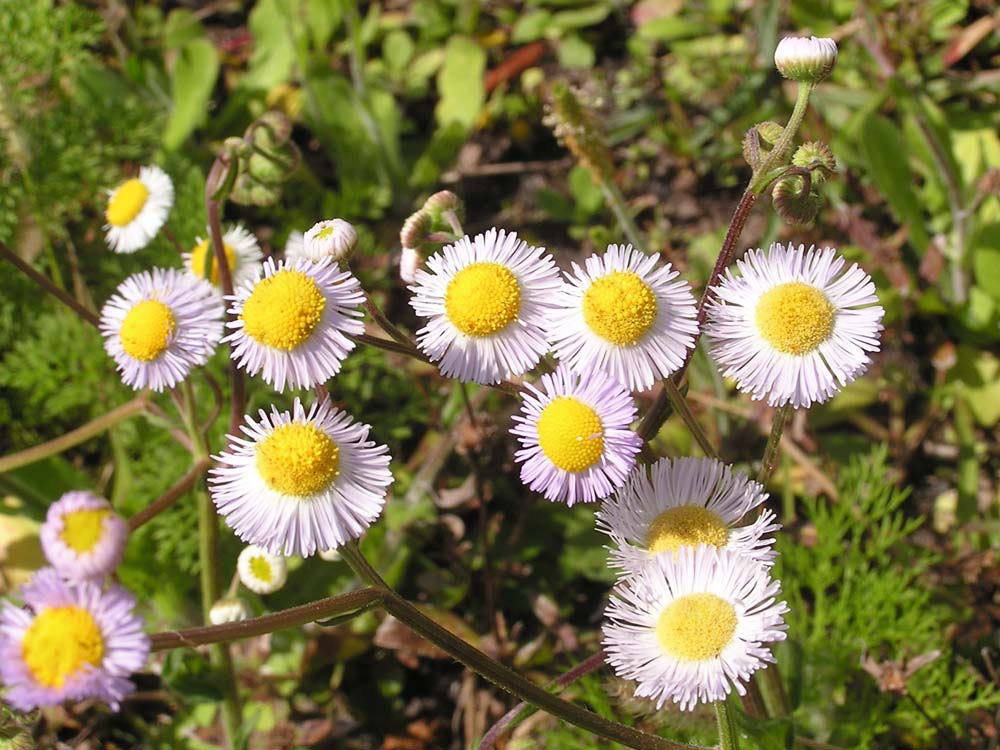Difference between revisions of "Erigeron quercifolius"
Krobertson (talk | contribs) (→Taxonomic notes) |
Krobertson (talk | contribs) (→Description) |
||
| Line 24: | Line 24: | ||
==Description== | ==Description== | ||
<!-- Basic life history facts such as annual/perrenial, monoecious/dioecious, root morphology, seed type, etc. --> | <!-- Basic life history facts such as annual/perrenial, monoecious/dioecious, root morphology, seed type, etc. --> | ||
| − | A description of ''Erigeron quercifolius'' is provided in [http://www.efloras.org/florataxon.aspx?flora_id=1&taxon_id= | + | A description of ''Erigeron quercifolius'' is provided in [http://www.efloras.org/florataxon.aspx?flora_id=1&taxon_id=25006666gin, w4 The Flora of North America]. |
| + | |||
| + | ''E. quercifolius'' can be a winter annual, biennial or short live perennial, depending on environmental conditions. Basal leaves have a deeply notched marith yellow-green leaves that are rough to the touch. Flower stalks emerge from the center of the basal rosette and can reach about 12-24 inches tall by early summer. The flower heads are small and are composed of many thin, ray petals surrounding a rounded yellow disc.<ref name="Native">[[http://hawthornhillwildflowers.blogspot.com/2014/01/daisy-fleabane-erigeron-quercifolius.html Native Florida Wildflowers]] Accessed: December 7, 2015</ref> Flowers can be blue, white or pink.<ref name="EOL">[[http://eol.org/pages/468955/details Encyclopedia of Life]]Accessed December 7, 2015</ref> | ||
| − | |||
==Distribution== | ==Distribution== | ||
==Ecology== | ==Ecology== | ||
Revision as of 16:14, 15 August 2016
| Erigeron quercifolius | |
|---|---|

| |
| Photo by Wayne Matchett, SpaceCoastWildflowers.com | |
| Scientific classification | |
| Kingdom: | Plantae |
| Division: | Magnoliophyta - Flowering plants |
| Class: | Magnoliopsida - Dicotyledons |
| Order: | Asterales |
| Family: | Asteraceae ⁄ Compositae |
| Genus: | Erigeron |
| Species: | E. quercifolius |
| Binomial name | |
| Erigeron quercifolius Lam. | |

| |
| Natural range of Erigeron quercifolius from USDA NRCS Plants Database. | |
Common name: oakleaf fleabane
Contents
Taxonomic notes
The common name, oakleaf fleabane, is due to the basal leaves being lobed like some oaks.[1]
Description
A description of Erigeron quercifolius is provided in w4 The Flora of North America.
E. quercifolius can be a winter annual, biennial or short live perennial, depending on environmental conditions. Basal leaves have a deeply notched marith yellow-green leaves that are rough to the touch. Flower stalks emerge from the center of the basal rosette and can reach about 12-24 inches tall by early summer. The flower heads are small and are composed of many thin, ray petals surrounding a rounded yellow disc.[1] Flowers can be blue, white or pink.[2]
Distribution
Ecology
Habitat
E. quercifolius can be found in wetland depressions, wet pinelands, dry turkey-oak pinelands, pine flatwoods, moist open hammocks, and peaty soils of cypress-gum swamps. It is a quick to colonize openings and disturbed areas such as roadsides, vacant lots, open fields, and drainage ditches. Soils include loamy sand, peaty soil, and shell rock. [1][3] Associated species include Helenium pinnatifidum, Parietaria praetermissa, Micromeria brownei, Spermacoce assurgens, Galium hispidulum, Vicia floridana, Commelina diffusa, Rumex verticillatus, Galium tinctorium, Boehmeria cylindrica, and Saururus cernuus. [3]
Phenology
It has an inferior ovary[4] and flowers March through October. [3] Fruits are achenes[4].
Pollination
The following Hymenoptera families and species were observed visiting flowers of Erigeron quercifolius at Archbold Biological Station: [5]
Apidae: Apis mellifera, Bombus impatiens, Epeolus pusillus
Colletidae: Colletes mandibularis
Halictidae: Halictus poeyi, Lasioglossum tamiamensis
Leucospididae: Leucospis robertsoni, L. slossonae
Megachilidae: Coelioxys germana, Dianthidium floridiense, Dolichostelis louisae, Heriades leavitti, Megachile albitarsis, M. parallela, M. petulans
Sphecidae: Bicyrtes capnoptera
Vespidae: Euodynerus hidalgo, Pachodynerus erynnis
Use by animals
It attracts predatory and parasitoid insects that will prey on pest insects. It is a host to thrips and aphids [6]. It is claimed that burning the foliage will chase away fleas and other pests[7].
Conservation and management
Cultivation and restoration
Photo Gallery
References and notes
- ↑ 1.0 1.1 1.2 [Native Florida Wildflowers] Accessed: December 7, 2015
- ↑ [Encyclopedia of Life]Accessed December 7, 2015
- ↑ 3.0 3.1 3.2 Florida State University Robert K. Godfrey Herbarium database. URL: http://herbarium.bio.fsu.edu. Last accessed: October 2015. Collectors: Loran C. Anderson, James R. Birkhaulter, Michael Cartrett, George R. Cooley, R.A. Davidson, Robert Doren, Richard J. Eaton, J.P. Gillespie, William T. Gillis, R.K. Godfrey, Ed Keppner, Lisa Keppner, R. Kral, O. Lakela, D.W. Mather, Joseph Monachino, John B. Nelson, C.W. O’Brien, Paul L. Redfearn Jr., Grady W. Reinert, Cecil R. Slaughter, Bian Tan, R.F. Throne. States and Counties: Florida: Alachua, Bay, Calhoun, Citrus, Collier, Columbia, Dixie, Franklin, Gadsden, Gilchrist, Gulf, Hamilton, Holmes, Indian River, Jackson, Jefferson, Lee, Leon, Levy, Liberty, Marion, Orange, Osceola, Pasco, Pinellas, Polk, Putnam, Santa Rosa, Taylor, Volusia, Wakulla. Compiled by Tall Timbers Research Station and Land Conservancy.
- ↑ 4.0 4.1 [Native and Naturalized Plants of the Carolinas and Georgia]Accessed: December 7, 2015
- ↑ Deyrup, M.A. and N.D. 2015. Database of observations of Hymenoptera visitations to flowers of plants on Archbold Biological Station, Florida, USA.
- ↑ [Bloomin crazy]Accessed: December 7, 2015
- ↑ [[1]]Accessed: December 7, 2015